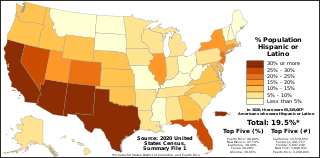| This article is part of a series on |
| Education in the United States |
|---|
| Summary |
| Issues |
| Levels of education |
| |
This list of U.S. states and territories by educational attainment covers the 50 U.S. states, the District of Columbia, and the territory of Puerto Rico and their populations' educational attainment for all people of at least 25 years of age. The four other inhabited U.S. territories (American Samoa, Guam, the Northern Mariana Islands, and the U.S. Virgin Islands) are listed separately.
Contents
The data source for the main list is the U.S. Census Bureau's American Community Survey in 2021. [1] The data source for the territories table is from 2010 U.S. Census Bureau data, because those territories are excluded from the American Community Survey. [2] [3] The American Community Survey is a large demographic survey collected throughout the year using mailed questionnaires, telephone interviews, and visits from Census Bureau field representatives to about 3.5 million household addresses annually, regardless of their legal immigration status. The survey does not measure graduation rates from different educational institutions, but instead, it measures the percentage of adult residents with a high school diploma. [4]
Overall, 90.3% of Americans over the age of 25 had graduated from high school in 2021, with the highest level found in the state of Massachusetts at 96.1% and the lowest in the state of California at 84.4%. In Puerto Rico, the proportion was even lower, though, at 79.6%. [1]
34.9% of Americans over the age of 25 had educational attainment of having a bachelor's degree or higher in 2019. The state with the highest percentage of people having a bachelor's degree or higher educational attainment was Massachusetts at 50.6%, and the lowest was West Virginia at 24.1%. The District of Columbia had a percentage significantly higher than that of any U.S. state at 63.0%. [1]
Advanced Degrees, such as Master's Degrees and Doctorates were held by 16.7% of Americans at least 25 years old in 2019. Advanced Degrees were most common in Massachusetts, with 26.3% of Massachusetts residents holding an advanced degree of any type since 2019 (it is regarded as the best state for Higher Education), and they were least common in Mississippi, with 9.3% of Mississippi residents holding an advanced degree. The District of Columbia had a percentage of 37.8%, higher than that of any state, while in the Commonwealth of Puerto Rico, 7.9% of Americans had an advanced degree, a proportion lower than any state in the U.S. [1]
As of the 2010 census, four U.S. territories (American Samoa, Guam, the Northern Mariana Islands, and the U.S. Virgin Islands) had educational attainment numbers below every U.S. state (and the District of Columbia). In the U.S. Virgin Islands, 68.9% had attained a high school degree or higher; in American Samoa, 9.9% had attained a bachelor's degree or higher. [2] [3]












